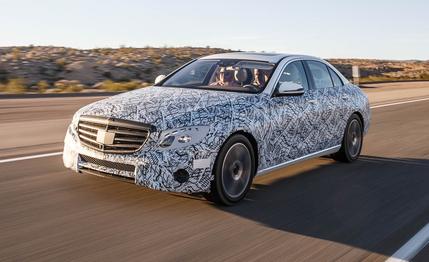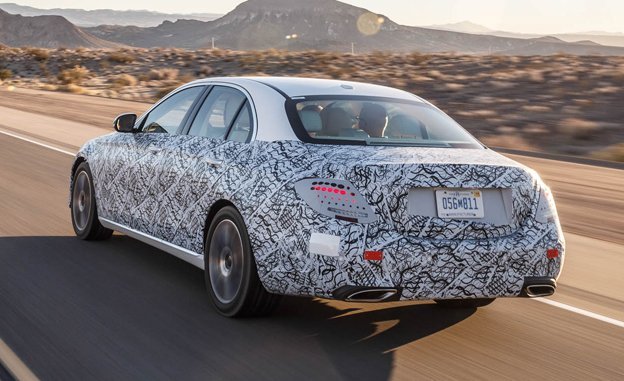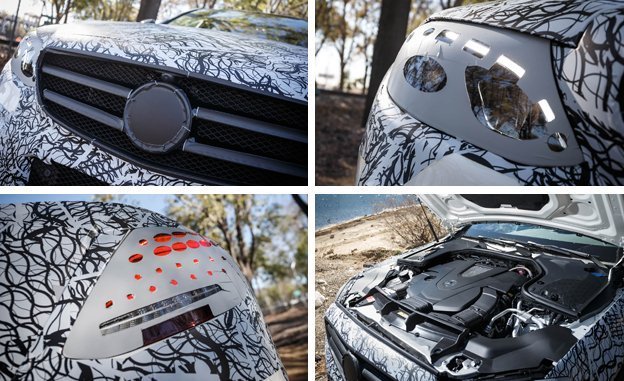 Prototype Drive
Prototype Drive
The Mercedes-Benz E-class is not just a prototypical luxury sedan, it’s the embodiment of the Mercedes-Benz brand. The redesigned, 2017 version of this all-important model will make its debut at the Detroit show in January, but prior to that we had the opportunity to participate in—from the passenger seat—one of the final test runs for the new model, from Los Angeles over the San Bernardino Mountains and on through the desert to Las Vegas. The two cars were a U.S.-spec E300 with a 2.0-liter turbocharged four-cylinder and a European-spec E400 with a twin-turbocharged V-6.
Above all, the E-class aims to remain the most comfortable sedan in its segment, and we expect Daimler will defend this position with ease. On these challenging U.S. roads, the pronounced bumps, expansion joints, and potholes seemed to almost disappear. The ability to reduce road, engine, and wind noise also is outstanding, and we detected no rattles or creaks, despite the cars’ prototype status.

Unlike previous generations of the E-class, however, the new model seems more willing to tackle twisty roads. Despite suspension tuning that hews toward comfort, the new sedan provides agile responses, and body roll is held strongly in check. The E-class will be available with 19- or 20-inch wheels.
As is typical, the new E-class will offer a wide range of gasoline and diesel engines internationally, but the choices will be more limited in the United States. Expect an E300, an E450 AMG Sport, and the monster Mercedes-AMG E63 S with about 600 horsepower. Mercedes plans to once again offer a diesel version, as well, and a plug-in hybrid could be added down the road. Eventually, there will be hybrids with an integrated starter-generator based on a 48-volt electrical architecture.
All models come with Daimler's new nine-speed automatic; the AMG version will get the "Speedshift" clutch pack in place of a conventional torque converter. 4MATIC all-wheel drive will be widely available. From the passenger seat, even the E300’s 2.0-liter turbo seems quick and responsive, and its lively character will be underscored by U.S.-specific tuning: What passes for Sport mode in Europe is actually used as Comfort mode in the States, with Sport and Sport+ sharpening the reflexes further.
Mercedes has managed to cut weight by roughly 150 pounds and improved the car’s aerodynamics (the European base model, which won't be offered here, is predicted to achieve a drag coefficient of 0.23). As a result, real-world fuel economy is expected to jump by close to 20 percent.

With its new bundle of driver-assistance systems—which we detailed this summer—the new E-class will also up the ante in the field of autonomous driving. The "Drive Pilot" maintains lane position and the distance to other cars at speeds up to 120 mph, and it doesn't even need clear lane markings at speeds up to 60 mph. In a curve, there’s assisted steering. Car-to-X Communication warns the driver of dangers lying ahead. In addition, when it’s in autonomous mode, the E-class will change lanes with a tip of the turn-signal stalk—a not-for-America feature that Daimler initially didn't feel was essential but decided to include after the enthusiastic media response to its inclusion by other carmakers (see Tesla Model S). What you can't do is retire to the back seat: The Drive Pilot requires that the driver periodically touch a sensor on the steering wheel. As seldom as once every other minute can be sufficient, but Daimler is "not interested" in videos taken from the back seat, an engineer remarked dryly.
Inside, the E-class impresses with an opulence that comes close to that of the flagship S-class and in some cases even exceeds it. The seats can be specified with even more massage options, and the optional instrumentation includes a wide, configurable screen. The entry-level gauge cluster includes three-dimensional dials, which are housed together under a somewhat aesthetically challenged chrome arch. One of the test cars was fitted with a Burmester audio system, and it was one of the best we’ve experienced.
In terms of exterior design, the E-class takes a big step forward compared with its boxy predecessor, adopting the familial look of the smaller C-class and the larger S-class. We like the new front end best with the classic chrome grille, topped by the upright, three-pointed-star hood ornament. After all, this is the quintessential Mercedes-Benz.